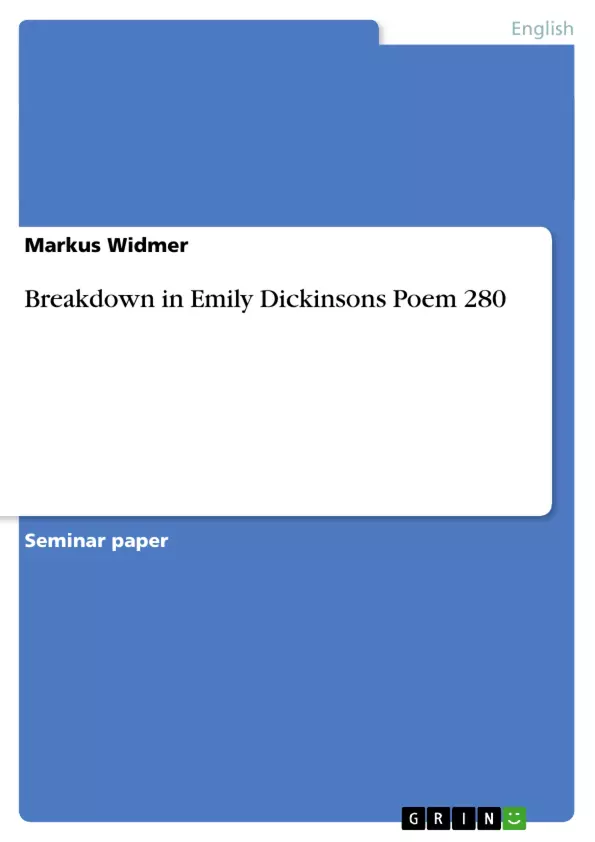This paper is a discussion of mental breakdown and its consequences on the lyrical self in Emily Dickinson's poem #280. It investigates the nature of the breakdown described in the poem as well as its results. The author's conclusion is that Dickinson points towards a new kind of perception beyond sanity, which is mirrored in the poem's use of language.
Inhaltsverzeichnis (Table of Contents)
- Introduction
- 1. Situations of the Narrator
- 2. Physical and Psychological Interpretations
- 3. Consequences of the Breakdown
- 4. Poetical Language
- Conclusion
Zielsetzung und Themenschwerpunkte (Objectives and Key Themes)
This paper analyzes Emily Dickinson's poem #280, "I Felt a Funeral, in my Brain," exploring the mental breakdown of the lyrical self and its consequences. The study examines the changing situations of the speaker, the relationship between physical and psychological interpretations of the poem, and the impact of the breakdown on the narrator's perception. The focus is on understanding how the breakdown is portrayed through poetic language and how it ultimately transforms the speaker's reality.
- Mental breakdown and its consequences on the lyrical self
- The changing situations and views of the narrator
- The relationship between physical imagery and psychological incidents
- The impact of the breakdown on the narrator's perception
- The use of poetic language to mirror the speaker's altered state
Zusammenfassung der Kapitel (Chapter Summaries)
- Introduction: This chapter introduces the subject of the paper, which is the analysis of Emily Dickinson's poem #280. The author outlines the main argument, which is that the poem describes a mental breakdown and its consequences on the lyrical self. The author also discusses the structure of the paper, outlining the different chapters and their respective focuses.
- 1. Situations of the Narrator: This chapter analyzes the changing situations of the narrator in the poem, arguing that they mirror the gradual loss of her reason. The author examines the three different views of the narrator – the internalized funeral, the distance from the sounds, and the eventual merging of the narrator with the imagined world – to demonstrate the progression of the speaker's breakdown.
- 2. Physical and Psychological Interpretations: This chapter explores the interpretations of poem #280, specifically addressing the question of whether it describes physical or psychological incidents. The author challenges interpretations that view the poem as a description of fainting and argues instead that the poem depicts the breakdown of sense, meaning sanity. This chapter examines the use of physical imagery to describe psychological experiences and considers the potential reasons for this choice.
Schlüsselwörter (Keywords)
This paper focuses on the themes of mental breakdown, loss of sanity, and altered perception in Emily Dickinson's poem #280. Key concepts include the speaker's changing situations, the relationship between physical and psychological imagery, and the use of poetic language to portray the narrator's internal world. The analysis explores the consequences of the breakdown on the lyrical self and examines how Dickinson uses language to convey the speaker's altered reality. The paper also considers the broader implications of the poem's themes and its insights into the human experience of mental health.
- Citar trabajo
- Mag. Markus Widmer (Autor), 1995, Breakdown in Emily Dickinsons Poem 280, Múnich, GRIN Verlag, https://www.grin.com/document/14778



